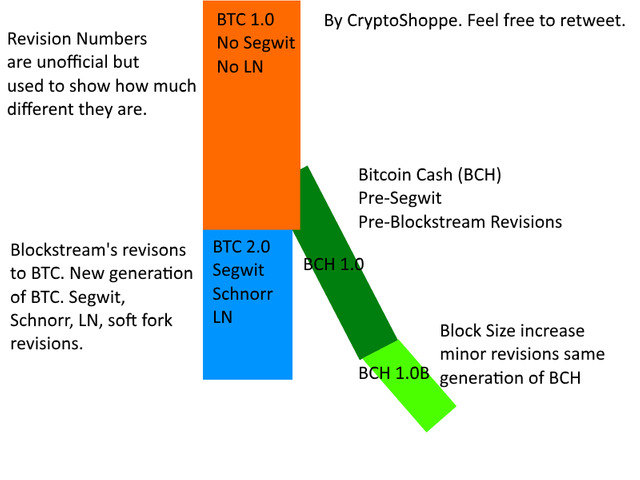Bitcoin (BTC) Is Scaling Onchain And Offchain As Well - Bitcoin Cash (BCH) Isn’t Scaling At All
Bitcoin Cash forked off from Bitcoin around 11 months ago with the promise to solve the scaling issues. After that day Bitcoin and Bitcoin Cash went their own way to evolve by following their own vision. Bitcoin implemented Segwit and started to build 2nd layers like Lightning Network, Liquid and RSK and Bitcoin Cash increased the blocksize through two hardforks. How is the situation 11 months later?

What will be the winning scaling strategy?
Onchain scaling
Onchain scaling means increasing the capacity for transactions to be registered on the blockchain. Every ten minutes a block is created and this block could only contain a maximum of 1MB transaction data before the first of August 2017. Both BTC and BCH implemented solutions to increase the capacity, but they took a different route.
Bitcoin Cash onchain scaling
BCH increased the blocksize to resolve this issue. When they split off the blocksize was increased to 8 MB and a later hardfork quadrupled the capacity to 32 MB. This means that the capacity of the BCH blockchain is now a 32 fold of the pre-fork capacity. However, it is not proven yet that the nodes can handle that load.
Bitcoin onchain scaling
Bitcoin took another approach: Segwit was implemented to reduce the size of a transaction and enable the same 1MB blockspace to contain more transactions every ten minutes. Segwit was implemented through a softfork instead of a hardfork and the relative blocksize was increased instead of the absolute blocksize. This means that the propagation time of blocks and requirements of hardware to synchronise with the blockchain didn’t increase. Beside that, Segwit is an important malleability fix that enables the engineers to build secure second layer solutions on top of Bitcoin.
Scaling comes with tradeoffs
Scaling can’t be done for free, it always comes with tradeoffs. When the blocksize is increased extra capacity is created instantly and the network can grow along with the increasing adoption, but relevant tradeoffs have to be made on security and decentralisation. When the blocksize is not increased adoption can only grow as fast as new innovation allows it to and hard work have to be delivered, but the level of security and decentralisation can be maintained. Here some important facts to realise:
Softforks preferred over hardforks
A softfork is backwards compatible while a hardfork is not. This because a softfork makes changes within the fundamental rules of the network and a hardfork changes the fundamental rules itself. When a softfork happens participants of the network can choose whether they want to run the new rules or stick to the old ones, when they don’t upgrade their software they will still be able to participate in the network like before.
A hardfork is compulsory, when you don’t like the new rules and don’t upgrade your software you will not be able to synchronise with the network anymore and thus be kicked off. A hardfork actually creates a new coin that is not compatible with the old coin anymore. This means that hardforks, especially when they happen often destroy the store of value proposition because it highly decreases the certainty that the coin you buy today will be still the same coin anywhere in the future. Also the community will hardfork easier every time and that will lead to centralisation because ‘leaders’ can push important changes easier every time.
Linear VS exponential
The capacity will grow linear by increasing the blocksize and exponential by implementing efficiency upgrades. When you want to triple the capacity through a blocksize increase you have to triple the blocksize. Segwit will increase the relative blocksize by 2 to 4 times and Schnor Signatures (the proposal is being written as we speak) will increase it another 25% and other solutions will follow in the future with additional increases.
When we are conservative and count Segwit as a 100% (2x) increase the capacity of BTC will be 1MB x 2 x 1.25 = 2.5 MB after Schnor is implemented (and fully adopted). This means the absolute blocksize is still 1 MB, but the relative blocksize is 2.5 MB. As you can see, every upgrade will add up exponentially, it will also increase the effect of the previous upgrades. Even IF the community finally decides (with consensus) that an absolute blocksize increase is needed it is way more efficient.
To reach the same capacity as BCH the absolute blocksize only have to be increased to 12.8 MB to have a relative blocksize of 32 MB and thus the same capacity as BCH, but with less than half the effect of the trade offs!
Storage of the blockchain
When you increase the absolute blocksize it will lead to more data per block and thus more storage requirements to store the blockchain. A transaction made on the blockchain will be stored forever on every full node of the network. The question is whether a payment for a cup of coffee is important enough to be recorded forever and suck resources from node operators who don’t get paid anything to do so forever. Maybe it is more efficient to buy your coffee offchain without a record and a house or car onchain to be recorded forever in a super secure way.
Resources to validate the blockchain
When the absolute blocksize increases the required resources to run a full node will increase too. This will make it impossible to run a full node on smaller and cheaper devices and increase the costs of a full node overall. Over time only rich entities can afford to run a full node and this will lead to centralisation and make the network less resilient. On top of that it should be an individual right to have the ability run a full node since it is the only way to not have to trust a 3rd party and maintain monetary sovereignty.
Propagation time of blocks
Bigger absolute blocks means more data to be send and this means slower propagation times. When miners and nodes have to wait longer to receive a newly created block multiple vulnerabilities pop up. Attacks like double spend and selfish mining become easier and the chance of orphan blocks increases.
The current situation
The entire story above was about the maximum blocksize, but currently most blocks that are created are not full and thus smaller. In the last week Bitcoin managed to have bigger than 1 MB blocks on average, this means that the network is now handling more onchain transactions on average than was even possible in one single block before the first of August. Bitcoin is scaling on chain!
Bitcoin Cash had an average of 50 KB blocks over the last week and never managed to reach an average of above 100 KB. This means that Bitcoin Cash blocks are 20 times smaller than Bitcoin blocks before the first of August, so Bitcoin Cash didn’t scale at all.
Bitcoin is scaling onchain! Bitcoin Cash is not!
Offchain scaling
The most interesting part of Segwit is that it is a mailability fix and thus enables 2nd layers to be build in a secure way. Multiple second layers are being build, but Lightning Network is a really exiting one that will hugely increase the transaction capacity of the Bitcoin network. Lightning is being adopted fast as we speak and gives Bitcoin users the ability to make millions of extremely cheap and instant payments offchain.
Bitcoin Cash rejected Segwit so offchain payments are not possible for them. They also excluded themselves from being part of a greater network when the Lightning networks of multiple cryptocurrencies can be connected through atomic swaps. Decentralised exchanges with instant settlement and without counterparts risk will be build on this technology and BCH will not be part of it.
On top of that….
Beside the negative effects of the hardfork and blocksize increase itself there are also other issues to consider. Firstly, Bitcoin has the network effect and the biggest infrastructure and will thus be more valuable than Bitcoin Cash even if all other variables were even. Also the hash rate on Bitcoin is ten times higher and this makes Bitcoin Cash extremely vulnerable. Furthermore, the much bigger and more talented group of devs behind Bitcoin will be more likely to solve an emergency situation and give a better outlook on the innovation to come.
Conclusion
The conservative view on scaling of the Bitcoin Core developers enabled Bitcoin to scale slowly but without tradeoffs. Their choice was definitely to scale Bitcoin as fast as innovation goes while maintaining the fundamental features instead of scaling as fast as adoption goes while giving up security and decentralisation.
The disadvantage of this path is that we experienced high fees and slow transactions for a while in 2017, but if you imagine that Segwit and thus the scaling progress has been blocked for a year in effort to force a blocksize increase through a hardfork it probably wasn’t even necessary. Bitcoin is clearly scaling at the moment and we could have been here already a year ago.
Thank you Roger, Jihan and Faketoshi!
Bitcoin Cash gave up security, decentralisation, the brand name and network effect to execute some hardforks. Despite all these sacrifices the blocks are now 20 times smaller than the pre-2017 Bitcoin blocks because nobody is using it. Beside degrading their own network they also damaged Bitcoin by delaying working scaling solutions for more than a year, spreading lies and manipulating markets to pump their own shitcoin, creating attack vectors and instability because of copying the mining algorithm and destroying the game theory that miners will not attack Bitcoin because it will make their expensive hardware obsolete.
Disclaimer
This is no financial advice, just my view on the market.
Never stress in a bear market anymore: Follow my diversification protocol
Store your Bitcoins securely
Ledger hardware wallet
Trezor hardware wallet
Trade Cryptocurrencies
Binance Exchange
Buy Bitcoins anonymous with cash
Localbitcoins
Protect your privacy with VPN and pay with crypto
Torguard
Buy gold securely with Bitcoin and store in Singapore
Bullionstar
Like this post? RESTEEM AND UPVOTE!
Something to add? LEAVE A COMMENT!

Bitcoin Cash (BCH) is a goal post move that doesn't advance it's coin enough from a technical standpoint.
Bcash sucks
Almost 1 year has passed and we still haven't seen anything of what BCH proposed to do... To succeed you have to be different, but in this case BCH fork was pathetic, I don´t know if it is because of the team behind it or if what they want to do is too hard, but the reality is that BTC is still so much better!
Btc sucks lol if you like high fees and slow times than you're delusional af
Not if your using the LN or sidechains
@michiel When BCH Touch again ATH?
Bitcoin cash needs some changes but is ot possible.?
bitcoin is very powerful....its have the power to change our life
You are doing great dear.
I found this blog helpfull.
Such an amazing work DUDE.
Keep it UP... Dear...
You can check my BLOG Also..
@abbasuet5780
Roger Ver would argue in another way haha
Earn Free $900 or as much as $2 million in 1 year on Coinpot. Free BTC, DOGE, LTC, BCH, DASH.
https://steemit.com/coinpot/@leonyaniazi/earn-free-usd900-or-as-much-as-usd2-million-in-1-year-on-coinpot-free-btc-doge-ltc-bch-dash
Thanks for descriptive post, well researched and well written but I want to say as "Bitcoin" is the mother currency of all coins and it is keep going down so for It is really difficult situations for BCH to emerge soon.